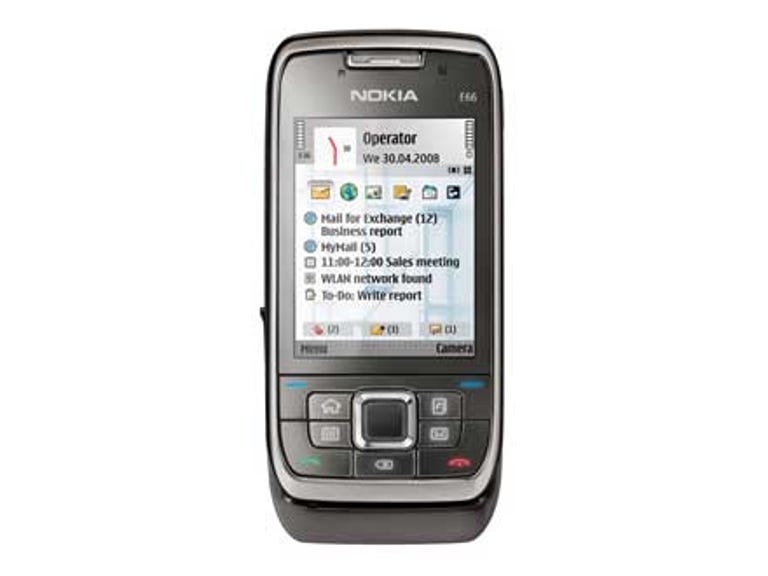 Why You Can Trust CNET
Why You Can Trust CNET Nokia E66 review: Nokia E66
While we like the E71 better, the E66 is a great smartphone with class leading features. If you want the functionality of a business phone without the bulk of a PDA form factor, the E66 is the phone you've been looking for.
Design
At the beginning of the movie RoboCop a regular policeman is covered in shiny metal and becomes a super policeman, a RoboCop, if you will. That's a tremendously watered down version of the tragic start to this film, but in similarly simplistic terms we can see how Nokia has improved last year's popular E65 smartphone: they've covered it in shiny stainless steel and made it sleeker and sexier.
The Good
The Bad
The Bottom Line
Yet, physically speaking, there is still so much of the E65 in the E66. From the size of the handset, to the placement of the menu keys, to the tiny phone-shaped speaker above the screen. Just as you can recognise Officer Alex Murphy in the RoboCop outfit, so too can you easily see the E65 in the E66. This newer model is marginally longer to accommodate the larger 2.4-inch colour screen, and is ever-so-slightly thinner, measuring in at 13.5mm deep.
The build quality of the E66 is outstanding. The handset as a whole feels solid and has a pleasing weight, and similar to the E71, the battery cover is textured with an appealing dimpled grid. The sliding mechanism on the E66 is smooth and controlled, feeling similar to the slider on the AU$1,800 Nokia 8800 Arte.
With its sleek slider design, and lack of QWERTY keyboard, the E66 is the business phone to appeal to people who want the flexibility of a smartphone without necessarily having a serious business intention, or who hate the larger form factors of most business phones. As such, the E66 features a 2.5mm headphone port and a microSD card slot for expanding the phone's memory and filling it up with music and videos. The E66 isn't a media phone, strictly speaking, but it is more than capable of busting out some tunes on public transport.
Features
Different to Nokia's E-Series releases of last year, the distance in regards to specs between this year's models, the E71 and the E66, is much closer. Sifting through the menus of the E66 is an identical experience to doing the same with the E71, they share matching connectivity options in 3.5G network speeds, Wi-Fi and A-GPS receivers, and the same 3.2-megapixel camera.
In fact, one of the few differences between these phones is that the E66 features an orientation sensor, meaning the display changes from portrait to landscape depending on how you are holding the phone. This isn't a new feature in phones, but while most phones only rotate the display in certain apps, like the Web browser or photo gallery, Nokia takes the idea a step further allowing you to adjust the orientation regardless of which application is running. This sensor also silences the ringtone on incoming calls when the phone is turned over, without cancelling the call.
The "E" in E-Series stands for Enterprise and like its business focused brethren, the E66 makes a very handy business sidekick with excellent email options, access to Microsoft Exchange servers for syncing mail, contacts and calendars with MS Outlook, a VPN client for accessing your company's intranet, as well as the ability to view MS Office documents (Word, Excel and PowerPoint) with the option to upgrade and be able to edit these documents from your handset. We've been able to install the necessary certificates and easily gain access to our office Exchange mail server and have new messages pushed to the phone.
Performance
Not only do the E66 and E71 share preloaded options and software, but they also have 128MB RAM and apparently make use of the same 369MHz ARM processors. Strangely, the E66 doesn't seem to process as quickly as the E71, but it's light years faster than last year's sluggish E65 and a slew of other smartphones we've seen this year.
One major difference between these two recent Nokia's is the size of the included batteries, and the resulting performance. We gave high praise to the E71 for its average of four days battery life. The E66 falls short of this, with cycles between two and three days depending on usage.
A new feature for both E-Series phones is easy-to-use multitasking. Pressing and holding the "main menu" key (the one that looks like a house) displays icons for all currently opened applications — similar to holding Alt-Tab on your PC. Using this menu you can quickly switch between apps, or use the backspace key to close an opened program, thus freeing valuable memory. This system works extremely well and the E66 is more than capable of having several processes active without significantly lowering performance.
Overall
As a smartphone the E66, like its predecessor, offers a portable alternative to the mostly bulky smartphones it competes against. We think the E71, with its excellent QWERTY keyboard and improved battery life, is a better option overall, but the matching productivity tools on these phones does mean that if you prefer a T9 numeric pad you won't be losing any functionality.


